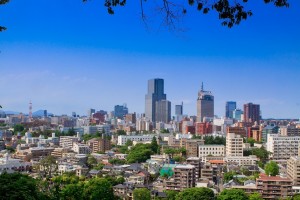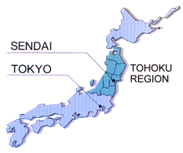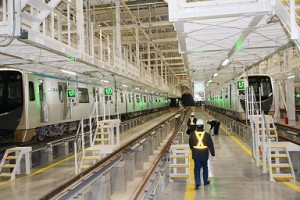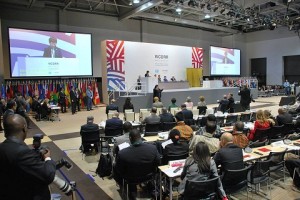Overview of Sendai
 Sendai City is at the centre of the Tohoku area in Japan’s northwest region. The population is around 1.07 million, and can be reached from Tokyo in around one hour thirty minutes using the Tohoku Shinkansen high speed train. With a reputation for being a city combining modern urban facilities in a natural green environment, as well as for having many tree lined streets and parks, Sendai is known as the ‘City of Trees’. Also, with many students living in various areas and with numerous live music venues, the city is also well known for its musical culture.
Sendai City is at the centre of the Tohoku area in Japan’s northwest region. The population is around 1.07 million, and can be reached from Tokyo in around one hour thirty minutes using the Tohoku Shinkansen high speed train. With a reputation for being a city combining modern urban facilities in a natural green environment, as well as for having many tree lined streets and parks, Sendai is known as the ‘City of Trees’. Also, with many students living in various areas and with numerous live music venues, the city is also well known for its musical culture.
Sendai City Government Website
Sendai Tourism Information Website
Developing new transport systems
From December this year the newly built Tozai Subway Line will start operation crossing the city from east to west. Together with the already existing Nanboku north-south subway line and bus system, public transport in the city will become significantly more convenient.
 As well as this, the ‘DATA BIKE’ bicycle rental system which began operation in 2013 is popularly used by locals and tourists alike. DATABIKE is a cycle network which links the rental cycles to a networked GPS system, where the bikes do not need to be returned to designated parking stations, and can be parked anywhere. With this flexibility use has been expanded and the convenience for users has been improved, as well as costs brought down. With the enhancement of public transport networks like this Sendai has become an easier city to live in and to visit.
As well as this, the ‘DATA BIKE’ bicycle rental system which began operation in 2013 is popularly used by locals and tourists alike. DATABIKE is a cycle network which links the rental cycles to a networked GPS system, where the bikes do not need to be returned to designated parking stations, and can be parked anywhere. With this flexibility use has been expanded and the convenience for users has been improved, as well as costs brought down. With the enhancement of public transport networks like this Sendai has become an easier city to live in and to visit.
Disaster Management
 This year in March, the Third UN World Conference on Disaster Risk Reduction took place in Sendai, with representatives from all over the world coming together to discuss international perspectives on crisis management strategy. At the main session held by the UN, around 6,500 people from 187 countries took part as delegates, with about 156,000 other participants such as local residents also taking part in the public forum. On the last day of the conference the ‘Sendai Framework for Disaster Risk Reduction 2015-2030’ and the ‘Sendai Declaration’ were adopted by the assembly.
This year in March, the Third UN World Conference on Disaster Risk Reduction took place in Sendai, with representatives from all over the world coming together to discuss international perspectives on crisis management strategy. At the main session held by the UN, around 6,500 people from 187 countries took part as delegates, with about 156,000 other participants such as local residents also taking part in the public forum. On the last day of the conference the ‘Sendai Framework for Disaster Risk Reduction 2015-2030’ and the ‘Sendai Declaration’ were adopted by the assembly.
Third UN World Conference on Disaster Risk Reduction Website
In Japan all areas are very much affected by natural disasters such as earthquakes and volcanic eruptions, and there is also much damage caused by torrential rain and the violent winds from typhoons.
 This being the case, Japanese local authorities, including Sendai City, have established disaster prevention plans for each municipality. Taking into consideration the characteristics of each municipality, the local authority, residents and private businesses will all react at each stage in their corresponding roles as listed in the plans, which are based on the scale of the disaster expected, when warned in advance of the coming emergency and dictate what is needed in the immediate aftermath. In addition, all those organisations take part in training, re-enacting disaster scenarios and role playing how they should react in the various situations. The training is done annually throughout the region at schools and businesses so that any emergency can be handled effectively when disasters occur.
This being the case, Japanese local authorities, including Sendai City, have established disaster prevention plans for each municipality. Taking into consideration the characteristics of each municipality, the local authority, residents and private businesses will all react at each stage in their corresponding roles as listed in the plans, which are based on the scale of the disaster expected, when warned in advance of the coming emergency and dictate what is needed in the immediate aftermath. In addition, all those organisations take part in training, re-enacting disaster scenarios and role playing how they should react in the various situations. The training is done annually throughout the region at schools and businesses so that any emergency can be handled effectively when disasters occur.
After the earthquake of March 2011, the issue for Japan is not only thinking about disaster prevention, but there has also been recognition of the importance of ‘disaster reduction’ as a concept.
 During large scale disasters, there are limits to how government and local authorities can respond. Bearing this in mind, there is focus on the idea that local areas have to deal to an extent with emergencies collectively, where citizens carry out their own ‘self help’ as well as in the community assisting each other as neighbours, in coordination with the ‘public help’ that is provided by public organisations such as local authorities. As an example and to show how communities are expected to react, citizens are encouraged to store several days worth of food in their homes for emergencies, which can be used to not only sustain themselves but also people in the area who are adversely affected by any emergency, to be used while waiting for the relief provided by local authorities, such as additional food, power and water provisions. These are the kinds of responsibilities divided amongst the parts of the community that are reflected in the planning and practice of disaster drills.
During large scale disasters, there are limits to how government and local authorities can respond. Bearing this in mind, there is focus on the idea that local areas have to deal to an extent with emergencies collectively, where citizens carry out their own ‘self help’ as well as in the community assisting each other as neighbours, in coordination with the ‘public help’ that is provided by public organisations such as local authorities. As an example and to show how communities are expected to react, citizens are encouraged to store several days worth of food in their homes for emergencies, which can be used to not only sustain themselves but also people in the area who are adversely affected by any emergency, to be used while waiting for the relief provided by local authorities, such as additional food, power and water provisions. These are the kinds of responsibilities divided amongst the parts of the community that are reflected in the planning and practice of disaster drills.
As well as receiving lots of support from people from all around the world, Sendai were also able to explain at the World Conference on Disaster Risk Reduction for those overseas to understand how the recovery in the region is continuing. Four years on the citizens are still very grateful for all the assistance that they received from the United Kingdom and JLGC would like to take this opportunity to express our deep thanks to the people of the Great Britain.
Pictures courtesy of Sendai City

